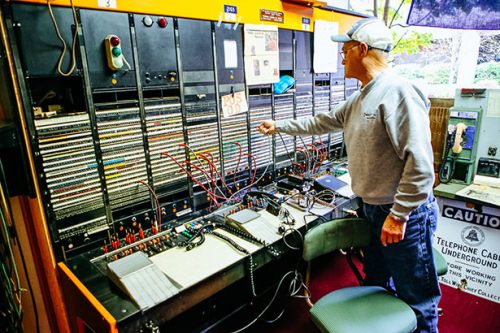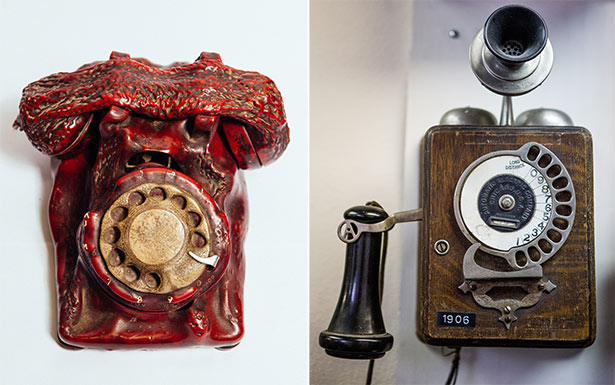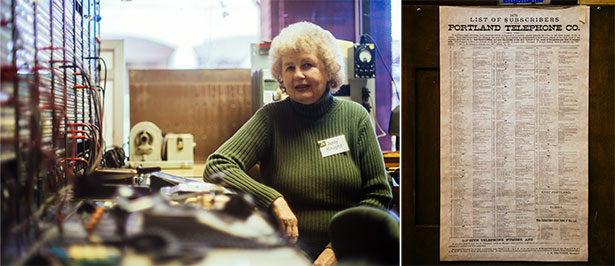
“Best-kept secret” doesn’t begin to describe Eugene’s Telephone Pioneer Museum. Though visibly situated next to the CenturyLink building downtown on East 10th Avenue, the place is only identifiable from the street by an oblong window displaying rotary telephones and a small, red-lettered sign on the door reading: “MUSEUM.”
And “museum” isn’t quite the right description, either. Walking inside the rectangular room feels more like stepping into the crowded attic of some aged and nostalgic collector.
Sitting at the small metal front desk to greet me is Judy Knight, 74, who calls me “dear” without a moment’s hesitation. She turns down the talk show humming from the little desk radio and looks so delighted to see me that I wonder if it’s rare she gets company during her shift, or if she’s just an exceptionally warm person — both, it turns out.
“On average over a month, I’d say we get five or six visitors,” says Knight, her blue blouse blending with the iridescent turquoise of the wire insulators displayed behind her. Her estimation isn’t impossible to believe, as the museum’s hours of operation are few — Thursdays only, between 10 am and 2 pm — but still, I’d guess there would be more patrons, given the place’s unique charm.
As my eyes wander, it’s easy to imagine that the low voices of the still-droning talk show are emanating from the antiques lining the walls: a turn-dial desk telephone in a faded 1950s powder blue; an early touch-tone phone with a half-legible handwritten label stating the donor’s name — in this case, a man who had simply walked in and dropped the thing on the desk a few years prior.
Bunched-up chunks of cables hang beside rusted steel pole gaffs (curved, pick-like foot instruments used by linemen to ascend utility poles). There’s a giant switchboard used in the early 20th century by Oregon’s historic Shaniko Hotel, an old wooden phone booth just big enough to stand in and not an inch of free space anywhere.
Knight is forthright about the museum’s present struggle to attract visitors. She doesn’t come close to conveying, though, exactly how uncertain the museum’s future is.
Eugene’s chapter of the Telephone Pioneers — the telecommunications company nonprofit that runs museums like this one nationwide — is folding this year due to lack of leadership. The chapter, called the Cascade Council, is made up entirely of retired telephone company workers such as Knight, and as the group has aged, it’s become more difficult to recruit for board positions. This has been a sweeping national trend for Telephone Pioneer organizations; just 20 years ago, there were 16 chapters in Oregon, and now that number’s been reduced to two.
Though CenturyLink plans to allow the museum to continue using the space free of charge after these Pioneers disband, the issue of consistent volunteer staff remains. Knight, the current Cascade Council president and a museum volunteer of eight years, says, “The volunteers I have right now are willing to continue, as long as they’re totally able.”
But what happens when that’s run its course, and what is at stake if the place were to close? Quite a lot, says Kingston Heath, UO professor and director of UO’s Historic Preservation Program.
“Being able to tell the story of telecommunications history in this country is a vital part of who we are,” Heath says, describing the telephone’s progression as indispensably instructive both in itself and in its cultural contexts. “So this museum has a role … but I’m not sure it can be sustained on the basis it is now.”
 |
|
A telephone melted in a Chicago fire, 1983 (left), Strowger automatic electric Chicago telephone, 1906.
|
Phone Home
Only three comments adorn the Telephone Pioneer Museum’s Yelp page. All are glowingly positive, though one reviewer admits that “in truth I have never made it inside,” and another says, “Never been in it.”
The Yelp page, the museum’s lone online presence, lists a phone number that connects me not to the museum but to the hesitant voice of Joan Wiechmann, whose now-deceased husband, Frank Wiechmann, was once its curator.
“Oh, I don’t know who put that number there, but now I just can’t figure out how to take it down,” Wiechmann says, explaining that she doesn’t have the museum’s direct number and recommends instead that I stop by in person to ask my question.
When I tell Knight about this interaction, she says that Joan Wiechmann gets these kinds of erroneous calls all the time.
Knight and Wiechmann are two of a line of museum personnel tracing back to its opening in 1983. And the Telephone Pioneers organization itself (now often called the CenturyLink Pioneers) is much older than that. “We celebrated our 100 years in 2011,” Knight says.
Despite its extensive history, the Cascade Council chapter has been steadily losing steam over the past five years.
“We meet once a month and have lunch, and just keep each other up with, you know, whatever happens to be going on,” Knight says. “Mostly funerals lately, unfortunately.”
On top of the problem presented by its aging volunteer pool, the museum doesn’t generate enough revenue to reach out via advertising. Admission is free, donations rare and often small.
Phil Gori, a Telephone Pioneer of “about 40 years” who recently began volunteering at the museum, says, “Sometimes people give a couple bucks or something. We just usually have them sign our book, so we knew somebody came to see us, anyway.”
Gori says he sought work in the telephone industry just because he was “looking for a job after I got out of the Navy,” and he says he later joined the Pioneers as “just a thing to do, I guess.”
Given how arbitrary this sounds, it surprises me when Gori says his wife, son, son-in-law and daughter have all held telecommunications jobs, too. “We’re a phone company family.”
When describing his son-in-law’s job, so different from the telecommunications jobs of his youth, Gori stumbles on his words a little, saying, “He’s a — what do they call them now? — a data technician.”
Dialing it Back
In the years Gori’s been connected with Eugene’s local telephone company, its name has changed from Pacific Northwest Bell to US West to Qwest to CenturyLink. The museum has been referred to as the Qwest Telephone Museum, and is still listed as such on several websites. Gori has seen the shift from rotary phones to key phones, touch-tone to cell; from lead cables to vinyl to fiber-optic. The installer repairman job he did for decades in his younger years no longer exists.
Now, like all the members of the Cascade Council, Gori’s involvement is limited to volunteer work and monthly chapter meetings.
“We meet once a month at Sizzler,” Gori says. “We have old books we bring in — we have a book exchange. We have a 50-50 drawing, and stuff like that. Just a regular nonsense meeting. Nothing serious.” He laughs.
While Gori’s involvement in the museum itself spans less than a year, there are still current members of the Cascade Council who remember the museum’s beginnings.
Take, for example, 89-year-old Al Rogers, who began working at the company in 1947 and was among the initial volunteers when the museum opened.
The entire collection, he explains, was donated or scrounged from garage sales. The behemoth vintage switchboard — the museum’s crown jewel — was given by the phone company as one of the first collection pieces. “It had to get dropped in there from the third story of a building with a crane,” Rogers says. “It’ll be a hell of a thing if it ever needs to be moved.”
Rogers isn’t saying outright that he thinks the museum will close unless more people step up to run it, but he might as well be. “Judy [Knight] has been president of our group for the last two years. And she can’t do it forever.”
He has an air of acceptance in regard to the Pioneers’ dwindling influence — and, by extension, a dwindling of a sense of community among telecommunications workers.
“When I first hired on, we had over 500 people working in that 112 E. 10th building,” Rogers says. Now, if he ventured a guess as to how many employees are at CenturyLink, he’d say, “Oh, 25. At the most.”
The fate of the little museum hangs in the balance, but recruiting new, young membership has proven nearly impossible. Rogers’ view on this seems plucked straight from memories of a slower era: “Young people are working all the time, and they don’t have time to volunteer,” he says. “There’s too many opportunities for young people to spend their time on these days.”
 |
|
Judy Knight. Portland phone book, 1878.
|
Call of Duty
Kingston Heath, the UO historic preservationist, isn’t ready to give up so easily.
“The potential’s there,” he says, but “there’s not a broad enough investment in that museum by other educational, volunteer, not-for-profit organizations.”
The first organization Heath suggests collaboration with is the one he works for.
Students in UO programs such as Arts and Administration, he says, could benefit from involvement with the museum, helping it keep more constant hours, building a functional web presence or even developing a phone app.
Heath also mentions the Lane County Historical Society, which has formidable archives and its own staff — “but they’re struggling like everybody else.”
However worthy the contents, Heath notes a general struggle among small museums in recent years because “the visiting public has changed.” Instead of touring historic places and viewing artifacts in person, “now people can access them through Google.”
What this means, in effect, is that museums are pushed to be more interactive, offering information and experiences that internet research can’t.
In its own ways, the Telephone Pioneer Museum is already accomplishing this. When a group of Weebelo Boy Scouts visited last month, Knight says they played happily at the switchboard for more than an hour. “They must have thought they were on the Enterprise or something!”
These hands-on convergences of old and young are the museum’s lifeblood, and Heath says they’re not just fun but integral to teaching younger generations how modern American culture was built.
The atmosphere in which the telephone came of age, Heath says, was “one of increased empowerment and spatial mobility.” It accompanied an increase in electrified homes and automobile use, as well as a pre-Depression prosperity that facilitated exploration.
“In terms of American culture, the telephone is a key, iconic artifact,” he says, “and we shouldn’t just put it in the trash heap of time.”
The Telephone Pioneer Museum’s significance — historically and culturally — all circles back to Judy Knight and the others who sit at the desk. They’re the ones who are happy to see you, who are always poised to talk about the good old days without trivializing them.
“They opened the museum because, at least when I worked for the company … we were really family,” says Knight. “And I think they wanted to see something to honor and remind people of what they’d been through.”
Whatever the museum’s future, it’s already a thing to be treasured. Its contents chronicle the history of human communication in this country, of ordinary interactions. Hardworking people like Knight are what bring it to life, and hopefully those are the same kind of people who will step up to keep it alive.
The Telephone Pioneer Museum is open from 10 am to 2 pm most Thursdays. Free admission. Call 541-484-8268 for more information.